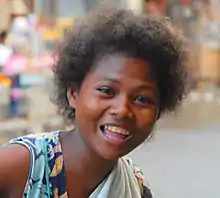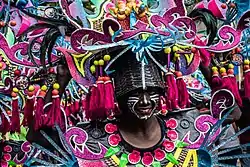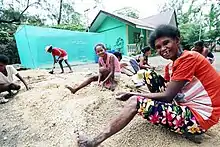Ati people
The Ati are a Negrito ethnic group in the Visayas, the central portion of the Philippine archipelago. Their small numbers are principally concentrated in the islands of Boracay, Panay and Negros. They are genetically related[3] to other Negrito ethnic groups in the Philippines such as the Aeta of Luzon, the Batak of Palawan, the Agta of the Sierra Madres, and the Mamanwa of Mindanao.[4]
 | |
| Total population | |
|---|---|
| 40,363 (2010)[1] (1980: 1,500 speakers of Ati)[2] | |
| Regions with significant populations | |
Western Visayas | |
| Languages | |
| Ati, Aklanon, Hiligaynon, Filipino | |
| Religion | |
| Animism, Christianity (Roman Catholic) | |
| Related ethnic groups | |
| Other Negritos, Visayans, and Filipinos |
History

The Negritos were the aboriginal (or first) inhabitants of the Philippine archipelago. They most probably arrived from Borneo 20,000 to 30,000 years ago, through what is thought to be an isthmus (remnants of which today comprise the island of Palawan) that in the prehistoric epoch connected the archipelago to Borneo via a land bridge.[5]
According to some oral traditions, they also predate the Bisaya, who now inhabit most of the Visayas.
Legends, such as those involving the Ten Bornean Datus and the Binirayan Festival, tell tales about how, at the beginning of the 12th century when Indonesia and the Philippines were under the rule of Indianized native kingdoms, the ancestors of the Bisaya escaped from Borneo and from the persecution of Rajah Makatunaw. Led by Datu Puti and Datu Sumakwel and sailing with boats called balangays, they landed near a river called Suaragan, on the southwest coast of Panay, (the place then known as Aninipay), and bartered the land from an Ati headman named Polpolan and his son Marikudo for the price of a necklace and one golden salakot. The hills were left to the Atis while the plains and rivers to the Malays. This meeting is commemorated through the Ati-atihan festival. This legend, though, is challenged by some historians.[6]
During Spanish colonization, the tribe made contact with the conquistador Legazpi and were exploited in his colonization of Panay.
Demographics
Language
The Ati speak a distinct Philippine language known as Inati. As of 1980, the speakers of Inati number about 1,500. Hiligaynon and Kinaray-a are also commonly used.[2]
Religion
The Ati practice a form of animism that involves good and evil spirits. These spirits are nature spirits that often guard rivers, the sea, the sky, as well as the mountains. Sometimes, they may cause disease or comfort. The Ati from Negros refer to them as taglugar or tagapuyo, which literally means "inhabiting a place." Christianity has also been adopted due to less isolation and more contact with "outsiders."
Ancestral lands
The National Commission on Indigenous Peoples (NCIP) granted to the Ati community on Boracay a certificate of ancestral domain title (CADT) in 2010.[7]
Atis were harassed and threatened in 2012 on two separate occasions by men identified with resort owners and local officials.[4] Ati youth leader Dexter Condez was killed on February 22, 2013.[8] The killing has not yet been resolved.[4]
The Supreme Court upheld the CADT in 2019 in favor of Atis against legal challenges mounted by private claimants.[9]
Culture

Clothing
Not too long ago, like other Negritos in the country, their clothing was simple, with women wearing wraparound skirts, sometimes made out of bark cloth, and men wearing loincloths. However today T-shirts, pants, and rubber sandals are common as daily clothes.
Jewelry is simple in nature. Some jewelry objects involve plants such as flowers, while others use animal bones; particularly the teeth of pigs.
Medicine
Ati are known in Panay as practitioners of herbal medicine. Locals often seek their help in removing leeches from a person's body.
Mobility
The Negritos traditionally were nomadic people, with the Ati of Panay being known as the most mobile. Now they live in more permanent settlements like Barotac Viejo, island of Guimaras, Igkaputol (Dao), Tina (Hamtic) and Badiang (San Jose de Buenavista). The famous island of Boracay is still regarded as their ancestral land as the area known as Takbuyan, between the municipalities of Tobias Fournier (Dao) and San Joaquin, on the southwestern coast of Panay. Very few of them are now nomadic (mostly women with small children). Ati men traditionally join 'sacadas' workers on time of harvest of sugar plants in places such as Negros or Batangas.
Festivals
The Ati are the central attraction in the Ati-atihan festival, a festival named in their honor. It is said that the festival is held to commemorate the first appearance of the Roman Catholic Church and the Spaniards in the province of Aklan. According to oral tradition, the Ati helped the Spaniards conquer the native Visayans and, as a reward, the tribe was given a statue of the Santo Niño.
In the Dinagyang festival of Iloilo City, also on Panay, performers are also painted to look supposedly like Ati and are organized into "tribes", called "tribus", to perform dances with drums, as the Atis are supposed to have done when the Malay arrived and bought Panay from the Ati. Dinagyang is held to celebrate this purchase as well as the arrival in Iloilo of the Santo Niño statue. When the statue first arrived in 1967, a tribe from the Ati-atihan festival was invited to Iloilo to mark the occasion.
Atis of Boracay


Atis are the original inhabitants of Boracay island. As the island gained fame, Atis were pushed away. They lost their lands and many were rendered homeless. Consequently, many migrated to the Caticlan mainland. However, President Duterte took the initiative of land reforms. In November 2018, land titles of 3.2 hectares were handed over to Atis.[10] Although, this is very small piece from the 1000 hectare area of the whole island. Lack of education, fear of discrimination and being bullied is visible among Atis of Boracay.[11]
The Philippine government through the Technical Education and Skills Development Authority (TESDA) has made efforts to increase Ati employability through scholarships for culinary and aesthetics training programs. Upon completion of these programs, they will graduate with a nationally recognized certificate.[12][13] The government is also making an effort to create employment opportunities; in 2019, the Aklan provincial government hired two full-time employees from the Ati community to oversee the crop production in the Ati Greenhouse which was set up as a source of income for the Ati community.[14]
References
- "2010 Census of Population and Housing, Report No. 2A: Demographic and Housing Characteristics (Non-Sample Variables) - Philippines" (PDF). Philippine Statistics Authority. Retrieved 19 May 2020.
- "Ati – A language of Philippines". Ethnologue. Retrieved 2007-03-26.
- "image from rafonda.com". rafonda.com. Archived from the original on 27 February 2007. Retrieved 2007-03-27.
- Resabal, Cooper (October 27, 2018). "After cleanup, Atis in Boracay hope to reclaim land". Vera Files. Retrieved 2020-06-20.
- Scott, William Henry (1984), Prehispanic Source Materials for the study of Philippine History, New Day Publishers, pp. xix, 3, ISBN 971-10-0226-4, retrieved 2008-08-05.
- "Kalantiao – the hoax". Paul Morrow. Archived from the original on 15 April 2007. Retrieved 2007-03-26.
- Buan, Lian (August 28, 2019). "Supreme Court affirms Ati ownership of 2-hectare land in Boracay". Rappler. Retrieved 2020-06-20.
- "Violence looms over Ati tribe ancestral domain in Boracay". Rappler. February 26, 2014. Retrieved 2020-06-20.
- "SC rules NCIP has primary jurisdiction over ancestral domain claims". ABS-CBN News. August 29, 2019. Retrieved 2020-06-20.
- "Boracay Atis get land ownership titles". cnn.
- Productive Employment for Indigenous People
- Share; Twitter. "TESDA to provide livelihood skills for indigenous people in Antique". www.pna.gov.ph. Retrieved 2019-07-03.
- Lomotan, Roi Anthoni; May 21, Georgette Malagar Published on; 2019. "Feature: Better future awaits IPs after TESDA training". pia.gov.ph. Retrieved 2019-07-03.CS1 maint: numeric names: authors list (link)
- "Aklan Province". www.facebook.com. Retrieved 2019-07-03.
